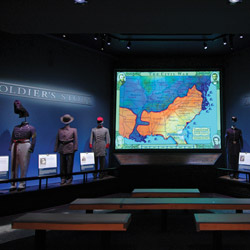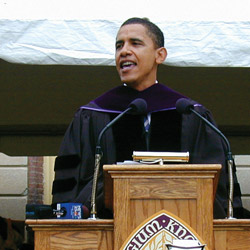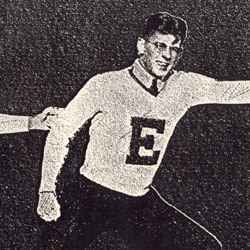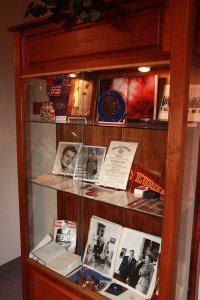
Obama. Lincoln. Reagan. Grant. They are some of our most beloved and revered presidents. Today, visitors flock to tourist sites crafted in their honor.
Four U.S. presidents have called the state of Illinois home, and the Illinois Bureau of Tourism has honored them all with official “Presidential Trail” designations. Each “trail”—including the recently created Barack Obama Trail—is a collection of highways that connect villages and cities of importance to the lives of these great leaders.
This summer, one and all can venture down Illinois’ presidential trails and experience the state’s rich culture and history through the lives of four presidents who lived and made their mark in the Land of Lincoln.
The Obama Surplus
After just a few months in office, President Barack Obama has already proven to be a boon for many businesses. With his face gracing the covers of books, magazines, coffee mugs and handbags, and with Obama O’s cereal promising “hope in every bowl,” his legacy will not soon be forgotten. More than 1,800 special Illinois license plates featuring his likeness were sold during a 60-day period this spring. From Yes We Can cola to Obama Blend coffee, his historic presidency has upped the ante in Illinois and redefined celebrity throughout the nation.
According to Alexander Wolfe’s “The Obama Economy,” few suspected that the Obama craze would last so long past Election Day, but an estimated $100 to $200 million is expected to be generated this year—just from “presidential” food items. Well into the fifth month of his first term in Washington, customers continue to clamor for Obamapolitans in restaurants across the country. In Manhattan, Obamatinis go for $15; on The Food Network, Obama Pizza Burger recipes sell like hotcakes. One New York-based tourism operator organized a Kenyan Presidential Heritage Safari at nearly $3,000 a head to take advantage of the president’s Kenyan roots.
Tourism is nothing new to Honolulu, Hawaii, of course. But since Hawaii native Barack Obama was elected the 44th president, tourism has taken an even bigger leap with a tour that takes a 90-minute jaunt through the middle-class neighborhood where Obama spent time as a preteen and teenager. Tour sites include the apartment tower where he lived with his late grandmother, locations near the school he attended from 1971 to 1979 and a walk by the ice cream parlor where he once worked. To capitalize on “Obama tourism,” the Hawaii Visitors and Convention Bureau created a site emphasizing Obama-related tourist sites at gohawaii.com/obama. The Galesburg Addition
The Galesburg Addition
But you don’t have to go all the way to Hawaii to take part in Obama tourism. Illinois is, after all, his home state.
It wasn’t long after the 2008 election that the Illinois Bureau of Tourism added a new presidential trail in honor of the current president. Sites on the Obama Trail include the University of Chicago Law School, where he taught constitutional law from 1992 to 2004; Chicago’s Grant Park, where he gave his victory speech; the Illinois State Capitol in Springfield, where he served from 1997 to 2004; and the Old State Capitol, where he announced his candidacy for president.
Closer to home, Knox College Director of Public Relations Karrie Heartlein says that Galesburg was added to the Obama Trail just before Christmas last year. “The Bureau of Tourism contacted us and asked if we would like to be added to the Obama Trail,” explained Heartlein. “I said: ‘Of course we do!’ I believe we’re an important part of Obama’s road to the White House.” Indeed, Knox College is woven throughout President Obama’s meteoric rise. He visited Galesburg just two days after receiving the Democratic nomination for the U.S. Senate in 2004. As a senator, he delivered the college’s 2005 commencement address.
“What I think is unique is when Senator Obama came for the commencement address, he spoke on ‘your place in history,’ and he asked students about their place,” recalled Heartlein. “The student speaker at commencement…turned behind him just before he began his speech, and said, ‘Hi, President Obama. Oh, sorry about that—I just wanted to see if it fits!’ Two graduates in the front row held up a sign that read ‘Barack for Prez.’ [Even then], these students could see the greatness in Barack Obama and in his future.”
Now-President Obama has spoken publicly about Galesburg on numerous occasions, most famously in his 2004 speech at the Democratic National Convention and again in an article for Time magazine the following year. During one of his visits to Knox, he sat in the famous “Lincoln Chair” in which the rail-splitter reclined during the famed 1858 Lincoln-Douglas debate. Memorializing the 16th President
Memorializing the 16th President
At 6’4”, Abraham Lincoln was our tallest president and the first to be assassinated. He was a storyteller and jokester, yet suffered from deep depression. The mark of our 16th president is evident throughout the state, but most evident in the central region. From Lerna, where the Lincoln Log Cabin State Historic Site preserves the 1840s farm of Lincoln’s parents, to Athens, where the Abraham Lincoln Long Nine Museum commemorates his legislative feats in the Illinois General Assembly, nearly every small town in central Illinois has a Lincoln tale to tell.
The story of Lincoln’s presidency—and of the man himself—is most spectacularly portrayed in the Abraham Lincoln Presidential Library and Museum in Springfield. His backwoods boyhood, tumultuous presidency and tragic death have been replicated in traditional and multimedia displays which have attracted more than 1.5 million visitors since the museum’s 2005 opening. Drawing visitors from more than 70 countries, the museum mixes 21st century technology with 19th century history and utilizes interactive exhibits, theatre and a 12-million-item research library—home to the world’s largest collection of pre-presidential Lincoln materials—to draw students and adults alike.
“The Lincoln Museum is for everyone,” says Brian Andreasen, research historian at the Abraham Lincoln Presidential Library. “You don’t need a guide. You can go at your own pace and pick and choose among the things that are of interest to you.”
The museum takes visitors through the early stages of Lincoln’s life growing up in Kentucky and Indiana in a phase known as Journey One. Journey Two relives the heroic battles of the Civil War, the untimely assassination of the president and the solemn occasion of his funeral, and includes the nostalgic Treasurer’s Gallery, with its handwritten copy of the Gettysburg Address, Lincoln’s glasses and shaving mirror, and Mary Todd’s music box and jewelry. Lincoln’s Eyes, a 17-minute synopsis of the 16th president as seen through the eyes of both supporters and detractors, is a favorite presentation given in the Union Theatre. But no dramatic innovation has been so acclaimed as Ghosts of the Library, which uses holographic technology to reinterpret history’s significance in the present day.
Andreasen says the museum is very “story-driven,” inviting readers to use their imaginations. In a dimly-lit room of Journey One, a clock ticks steadily while a statue of Lincoln idles in a bedroom doorway. The realistic portrayal of his wife leaning over the bed of her ailing son, Willie, who died at age 11, infects one with an eerie placidity. In another room, Lincoln and his administration debate legislation over a long wooden table while an actor in coat and hat invites tourists to “Come in. Join us!”
In Journey Two, a life-sized display of two men wrenching apart an African-American family at a slave auction projects a powerful image. Around the corner, a bank of TVs broadcasts a modern-day political news show hosted by the late Tim Russert of Meet the Press. The show features the four candidates of the 1860 election—Republican Abraham Lincoln, Northern Democrat Stephen Douglas, Southern Democrat John Breckenridge and Union Party nominee John Bell—followed by modern-day campaign ads for the candidates.
“The story of how Abraham Lincoln transcended the station into which he was born by taking advantage of the political opportunities government provided him is most compelling,” says Andreasen. “He lived the American dream, and that resonates with people, and I think that’s part of what intrigues people. Everyone can see a little bit of themselves in Lincoln’s life.”
As for the museum’s most memorable attractions, different facets strike people in different ways. Andreasen claims one popular element is the Whispering Gallery in Journey One of the tour. “You have the chance to hear and see all of the terrible things written about Lincoln during his presidency, which really surprises people,” he says. “It’s not our present-day image of Lincoln. I have yet to meet anyone who has had a similar experience in a museum, as far as presidential history is concerned.” The museum is open daily from 9am to 5pm. Cost is $10 for adults, with discounts for seniors, children, students and the military.
Just down the street from the museum, the Lincoln-Herndon Law Office lies within the only building in which Lincoln maintained a law office and is open to the public. Lincoln’s former Springfield home has been preserved and is worth a visit, as is the Lincoln Tomb State Historic Site at Oak Ridge Cemetery. In nearby Petersburg, the New Salem State Historic Site is a reconstruction of the village where Lincoln spent six years of his early adulthood and another popular favorite.
Lincoln Draws the Line
For residents of the Greater Peoria Area, pieces of Lincoln’s life are as close as their own backyard. Lincoln’s famous “Peoria Speech,” given on the lawn of the old Peoria County Courthouse, is considered by many the oration that would propel him into the Oval Office six years later. On October 16, 1854, Lincoln rode into town on horseback and gave a three-hour speech, answering Senator Stephen A. Douglas in a debate over slavery. So powerful were his words that Douglas was left speechless, declining a rebuttal. “He is as honest as he is shrewd, and if I beat him, my victory will be hardly won,” he said.
Just outside the courthouse at the corner of Main and Jefferson streets, a life-sized bronze statue of Lincoln called Lincoln Draws the Line commemorates the site of this famous speech. The Peoria Speech marked Lincoln’s re-entry into politics after serving a single term in Congress, and was his first significant address against slavery.
Across the Illinois River, the city of Pekin is rich in Lincoln history. Not only did he argue many cases in its courthouse, but it was a town known to Lincoln for nearly all his adult life. In 1832, he lodged there overnight on his way home from the Black Hawk War, in which he fought as a captain in the Illinois militia. He returned to Pekin year after year as a lawyer for sessions of the Tazewell County Circuit Court, staying for a week or two weeks each visit.
In the State House, Lincoln sponsored the bill that built the state road from Peoria to Pekin, and Pekin was in Lincoln’s district when he was a congressman. In fact, he may never have served in Congress at all had it not been for the “Pekin Agreement,” a bargain he struck with his political rivals at a party convention in the town that afforded him the nomination.
Lincoln the Lawyer
Before becoming a politician, Lincoln was first and foremost a lawyer. His famed 400-mile journey covering Illinois’ Eighth Judicial Circuit took him through many small towns in central Illinois where he was welcomed into people’s homes. He traveled the circuit for over 20 years, riding horseback six to eight weeks every fall and spring. Tourists can retrace this route for a glimpse of Lincoln’s lawyer days.
In Bloomington, you can take an audio tour of Lincoln-related sites with the president himself as guide at the McLean County Museum of History. The Old Lincoln Courthouse in Beardstown marks the site where Lincoln used an almanac to win acquittal for “Duff” Armstrong in the famous “Almanac Trial.” In the town of Lincoln, the Postville Courthouse State Historic Site showcases the typical activities of county government in the mid-1800s. The Mt. Pulaski Courthouse stands as one of two original courthouses from Lincoln’s time in the Eighth Judicial Circuit, and has been restored and interpreted as an operating 1850s courthouse. The Metamora Courthouse in Woodford County is the other original courthouse and is still in operation.
The Woodford County Historical Society has raised funds to erect a statue in the Metamora town square—a seven-foot-tall bronze replica of the 16th president. The Lincoln statue is accompanied by one of Melissa Goings, his last client as a lawyer traveling the circuit. World-renowned Lincoln sculptor John McClarey was commissioned to fashion the bronze duo. The statues will stand in the square, near a Looking for Lincoln wayside exhibit commemorating the relationship between the two. The statues will be unveiled in August for tourists young and old to witness.
From General to President
Just three years after Lincoln was assassinated, Ulysses S. Grant took the helm of the highest office. Grant, who became our 18th president, worked at his father’s side in a leather shop in Galena until the quaint normalcy of life was disrupted by the outbreak of Civil War. A West Point graduate, Grant quickly ascended to the top rank in the Union Army and became one of Lincoln’s finest generals. After the war ended, he returned to Galena, where he lived until he was elected president in 1868. Grant frequently returned to his hometown while serving in the White House.
The Grant Trail begins with the Ulysses S. Grant Home State Historic Site in Galena. Grant’s former home was a gift from the city’s residents in appreciation for his service in the war. In 1904, Grant’s children donated the home to Galena. It is open Wednesday through Sunday, with tours from 10am to 2pm.
Listed on the National Register of Historic Places, the Galena Historic District encompasses 85 percent of the city and consists of over 1,000 properties built before 1900. A guided tour of the district includes the DeSoto House Hotel, Illinois’ oldest operating hotel and previous host to Abraham Lincoln, Theodore Roosevelt and Ralph Waldo Emerson.
The Grant Trail ends with stops at the Galena Cellars Vineyard and Winery in Galena and the Massbach Ridge
Winery in Elizabeth. The popular wineries emphasize northwest Illinois’ breathtaking beauty and agriculture. Visitors can take part in wine tastings, vineyard tours and winemaking demonstrations.  Finding the Great Communicator
Finding the Great Communicator
Officially designated by the Illinois General Assembly in 1999, the Ronald Reagan Trail showcases Illinois towns and cities that helped shape Reagan’s formative years. The only one of the four Illinois presidents to be born in the state, Reagan lived with his family for more than 20 years in Tampico, Monmouth, Galesburg and Chicago, until he finally settled in Dixon from 1920 to 1933. But no place does his legacy shine brighter than at Eureka College.
“Yes, this place is deep in my heart. Everything that has been good in my life began here.” Such were the momentous words Ronald Wilson Reagan attributed to his alma mater. From the time he set foot on the college campus in the fall of 1928 until his commencement in the spring of 1932, he commanded the esteem of both peers and superiors. His certitude, relentless optimism and moral courage raised him from humble roots to become a proverbial hero, heralded for ending the Cold War.
The man who would later be known as the “Great Communicator” was chosen as a mere freshman to give a speech to a student body of 250. His oration, now known as the “Strike Speech,” defended students’ outrage regarding cuts in college funding and classes. With hypnotic inspiration, Reagan commanded audience attention as he spoke with passionate persuasion regarding his beliefs—beliefs grounded in a trusting in our better selves.
“This kid was so magnetic and so powerful—if he believed it, that did it!” exclaimed Brian Sajko, vice president of Admissions, Communications and Integrated Marketing and curator of the Ronald Reagan Museum. “He had very strong convictions he would not compromise, and he had a power that came from his unwillingness to compromise.”
“Dutch,” as Reagan’s father called him, enrolled at Eureka College with the encouragement of his minister, the Reverend Ben Cleaver of his hometown of Dixon. Because Eureka is a small college where the development of the individual takes the highest priority, Reagan seized every opportunity it offered a young man from modest beginnings. He appeared in 14 plays and was a member of the Tau Kappa Epsilon fraternity. He was the college’s lead swimmer, played football and ran track, and served two years in student government—elected as student body president his senior year. Graduating with a joint degree in sociology and economics would be the first in a long line of accomplishments that would eventually thrust Reagan onto the world stage.
“Eureka College is the living legacy of Reagan,” adds Sajko. “If you’re in college, you believe you can be president of the United States because Reagan was.”
And Reagan never forgot his alma mater, returning on numerous occasions. As governor of California, he dedicated the new Melick Library on September 28, 1967. At that time, he was presented a medallion, making him honorary president of the student council. In 1982, he returned to deliver a major foreign policy address that first announced his goal of an arms reduction treaty with the Soviet Union. His final appearance at Eureka came in 1992, when he delivered the commencement address at the 60th anniversary of his graduation.
“Eureka helped Reagan become who he was,” says John Morris, director of development for the Ronald W. Reagan Leadership Program and the Ronald Reagan Museum at Eureka College. “The moment of discovery—for Reagan—was Eureka College.”
Morris organizes fundraising to help expand the college’s role as a living legacy for Reagan. “We want to carry the leadership of Ronald Reagan forward,” he says. “The college has an ambition to represent Ronald Reagan, and we take that very seriously. We have created the Ronald Reagan Society that acknowledges all individuals and foundations that contribute five thousand dollars or greater to the Reagan membership to support his legacy.”
A Room Full of Stories
Although Reagan passed away in 2004, the 40th president is very much alive at Eureka College. His spirit lives on in the Reagan Museum, a collection of 10,000 personal and public objects Reagan donated to the college from each period of his life. Founded in 1994, the museum has educated about 150,000 visitors and is housed in the Donald B. Cerf Center on campus. It a room full of stories painting a portrait of Reagan from his college days and acting career to his service as California governor, campaign for the presidency, and two terms as president. It contains the largest collection of Reagan items outside the presidential library in Simi Valley, California.

“The museum shows the authenticity of what we’re saying [about Reagan],” says Sajko. “We’re not making it up. He came here. The stories we tell about Reagan are the stories that tell how he found out who he was—as we all do in college.”
The museum features quotes on the walls directly from the former president, highlighting his courage, idealism and faith in the American Dream. “I grew up at the time that Reagan was elected president, and I interned for the Reagan White House,” says Morris. “It was difficult not to be attracted to someone who exuded such optimism and belief in what it was to be an American. He believed in the individual—in the sense that you have to make it happen.”
Outside the museum, the Reagan Peace Garden features a bronze bust of Reagan at its center, created by renowned Peoria artist Lonnie Stewart, and a four-by-five-foot piece of the Berlin Wall, a gift from Germany. The attraction commemorates Reagan’s 1982 foreign policy address, hailed as “the beginning of the end of the Cold War,” and was dedicated in May 2000.
“People come from all over to pay respects to Reagan’s alma mater,” says Morris. “The idea of purpose and vision and voice—that idea is something that Eureka instills in its students.” Visit reagan.eureka.edu or call (309) 467-6407 for more information.
So if you’re tired of the same old summer activities year after year, make plans to trek the presidential trails. It’s a history lesson you won’t soon forget! iBi

